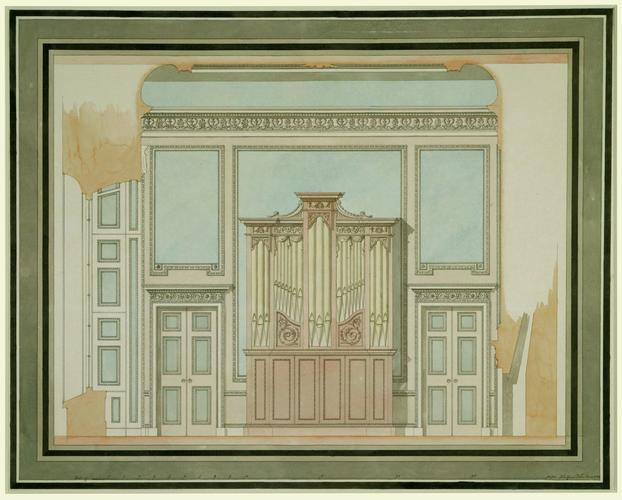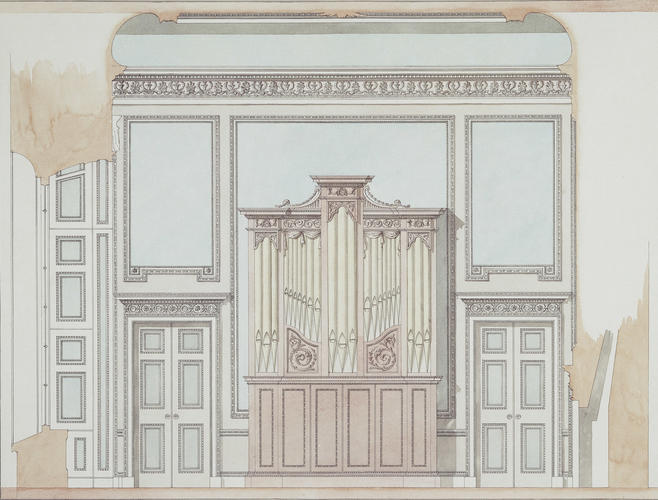John Yenn (1750-1821)
Design for the Music Room, Windsor Castle dated 1794
Pen and ink and wash | 49.2 x 64.1 cm (sheet of paper) | RCIN 918690
-
An elevation and cross-section of the organ and wall in the Music Room (now Crimson Drawing Room), Windsor Castle. Signed and dated, finished with colour washes.
John Yenn was a pupil of Chambers from 1764 and five years later was one of the first students to be admitted to the Royal Academy Schools, where he was awarded a gold medal in 1771. Drawings such as this well demonstrate his skill as a draughtsman, working with the techniques learnt in Chambers’s studio to produce drawings of great beauty and clarity. Yenn became one of the architect’s chief assistants. In 1774 Chambers described him as ‘an ingenious faithful intelligent servant’ who ‘for two or three years past has managed a great part of my extensive business very much to my satisfaction’. After the start of work at Somerset House, Chambers depended on Yenn increasingly, both in London and in the different projects commissioned by the King elsewhere. In 1782 Yenn was appointed by the Office of Works to the position of Clerk of the Works at Buckingham House and Kensington Palace. He was elected Royal Academician in 1791 and on Chambers’s death in 1796 he became Treasurer to the Royal Academy, actively (occasionally acrimoniously) involving himself in the politics of that institution.
After completion of his work on the Queen’s Lodge and Lower Lodge at Windsor, in 1781 Chambers was instructed to refurbish a set of apartments for the Prince of Wales in the eastern range of the Upper Ward. It is unlikely that the Prince used these rooms more than very occasionally, particularly after the start of work on Carlton House and Brighton Pavilion. In 1794 some of the Prince’s apartments were reallocated for the Queen’s use, and a fine new Music Room and Drawing Room were established there. The decoration of these rooms was part of the ‘Neo-classical Episode’ before the King’s decision to transform the castle into a Gothic palace with the help of James Wyatt.
The Music Room was on the approximate site of the present Crimson Drawing Room, created by Wyatville thirty years later. Because of the awkward configuration of the castle, it provided the main access between the private apartments and the State Apartments. The decoration was in a restrained and - by now - rather old-fashioned style. The ornamentation was limited to friezes and panels of foliage. The Music Room was to be painted in a mixture of pale blue, pink and grey, and the Drawing Room was to be yellow, lilac and broken white. Although the decoration of these rooms was the responsibility of Yenn, they continued the spirit of William Chambers which had by now been a presence at Windsor for nearly twenty years. Yenn’s designs, inscribed with dates between October 1794 and February 1796, are divided between the Royal Collection, the Royal Academy and the Victoria and Albert Museum.
The Music Room would have filled an important role in the lives of the royal family at Windsor. In 1788 the Princess Royal wrote that ‘A love of music to distraction runs through our family’. Music-making was part of their daily routine, from the earliest years of the reign. However, little is recorded of the furnishing and use of this room, apart from the fact that it contained a harpsichord (possibly Handel’s own instrument), and that in 1804 the King intended to have Roubiliac’s bust of Handel placed on a bracket above the chimneypiece on the west wall.
At the same period Yenn was also involved in the refurbishment of the State Apartments at Windsor and in the King’s projects at Buckingham House, including the redecoration of the Saloon following the removal of the Raphael Cartoons in 1787 and the provision of a new cold bath house for the King, erected in the garden to the south of the library wing. In addition, c.1800-1810 he worked on the Duke of Kent’s apartments at Kensington Palace.
Signed and dated John Yenn Delint Anno 1794
Catalogue entry adapted from George III & Queen Charlotte: Patronage, Collecting and Court Taste, London, 2004Provenance
Made for George III
-
Creator(s)
Acquirer(s)
-
Medium and techniques
Pen and ink and wash
Measurements
49.2 x 64.1 cm (sheet of paper)
Object type(s)
Other number(s)
RL 18690Alternative title(s)
Finished section of Organ, Music Room.










